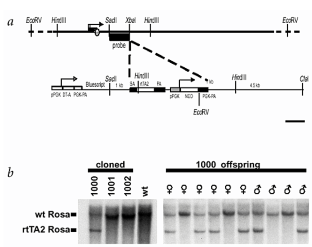Generation of mice from wild-type and targeted ES cells by nuclear cloning (original) (raw)
- Brief Communication
- Published: February 2000
- Teruhiko Wakayama2 na1,
- Anton Wutz1,
- Kevin Eggan1,
- Laurie Jackson-Grusby1,
- Jessica Dausman1,
- Ryuzo Yanagimachi2 &
- …
- Rudolf Jaenisch1
Nature Genetics volume 24, pages 109–110 (2000)Cite this article
- 1241 Accesses
- 255 Citations
- 9 Altmetric
- Metrics details
Mammalian cloning has recently been developed1,2,3,4,5, but a major obstacle has been the low frequency of viable clones, as most clones die during gestation or soon after birth. Parameters that affect cloning efficiency may include genetic background, passage number, cell-cycle stage of the donor cell6, loss of imprints, accumulated genetic damage of the donor cells or the ability of the oocyte to epigenetically reprogram the donor-cell nucleus. Cloning in mice5,7,8, the best mammalian model organism, has until recently been limited to freshly isolated or primary cultures of somatic cells, which limits study of the parameters that affect cloning efficiency. We have determined that established and targeted embryonic stem (ES) cells can generate cloned embryos and animals, thus making possible the study of parameters important for cloning.
To assess the most suitable genetic background for cloning, we compared cloning efficiencies using F1 (129SvJae×C57BL/6) ES cell lines and 129 (129SvJae) ES cell lines as nuclear donors. Nuclear transplantation resulted in blastocyst-stage clones at a similar frequency for all ES-cell donors (Table 1). After transfer into pseudopregnant females, 7 of 34 (21%) F1-cloned blastocysts developed to term and into healthy adults. In comparison, 8 of 76 (11%) inbred 129 donor ES cells developed to term, but all died within 24 hours of birth, demonstrating an effect of genetic background on survival. The viability of the F1-derived clones was also 5–70-fold greater than that reported for clones from other ES cell lines (R1, 4%, and E14, 0.3%; ref. 8). Thus, the F1 ES cells were more efficient as donors for nuclear transfer than the inbred 129 (J1 and E14) ES cells and the out-crossed 129 R1 ES cells. The ability of ES cells to generate viable cloned offspring might be correlated with their degree of polymorphism at 37 different SSLP markers (J1, 0/37; E14, 0/37; R1, 12/37; our F1 line, 28/37; ref. 9).
Table 1 Development of cloned embryos and mice from ES cells
This is a preview of subscription content, access via your institution
Access options
Subscribe to this journal
Receive 12 print issues and online access
$209.00 per year
only $17.42 per issue
Buy this article
- Purchase on SpringerLink
- Instant access to full article PDF
Prices may be subject to local taxes which are calculated during checkout
Additional access options:
Figure 1: Targeted insertion at the ROSA26 locus in cloned mice.

References
- Baguisi, A. et al. Nature Biotechnol. 17, 456–461 (1999).
Article CAS Google Scholar - Kato, Y. et al. Science 282, 2095–2098 (1998).
Article CAS PubMed Google Scholar - Wells, D.N., Misica, P.M. & Tervit, H.R. Biol. Reprod. 60, 996–1005 (1999).
Article CAS PubMed Google Scholar - Wilmut, I., Schnieke, A.E., McWhir, J., Kind, A.J. & Campbell, K.H. Nature 385, 810–813 (1997).
Article CAS PubMed Google Scholar - Wakayama, T., Perry, A.C., Zuccotti, M., Johnson, K.R. & Yanagimachi, R. Nature 394, 369–374 (1998).
Article CAS PubMed Google Scholar - Campbell, K.H., Loi, P., Otaegui, P.J. & Wilmut, I. Rev. Reprod. 1, 40–46 (1996).
Article CAS PubMed Google Scholar - Wakayama, T. & Yanagimachi, R. Nature Genet. 22, 127–128 (1999).
Article CAS PubMed Google Scholar - Wakayama, T., Rodriguez, I., Perry, A.C., Yanagimachi, R. & Mombaerts, P. Proc. Natl Acad. Sci. USA 96, 14984–14989 (1999).
Article CAS PubMed PubMed Central Google Scholar - Simpson, E.M. et al. Nature Genet. 16, 19–27 (1997).
Article CAS PubMed Google Scholar - Dean, W. et al. Development 125, 2273–2282 (1998).
CAS PubMed Google Scholar - Soriano, P. Nature Genet. 21, 70–71 (1999).
Article CAS PubMed Google Scholar
Acknowledgements
We thank H. Bujard for the rtTA2 construct. This work was supported by a grant from the NIH.
Author information
Author notes
- William M. Rideout and Teruhiko Wakayama: These authors contributed equally to this work.
Authors and Affiliations
- Whitehead Institute for Biomedical Research, Cambridge, Massachusetts, USA
William M. Rideout III, Anton Wutz, Kevin Eggan, Laurie Jackson-Grusby, Jessica Dausman & Rudolf Jaenisch - Department of Anatomy and Reproductive Biology, John A. Burns School of Medicine, University of Hawaii, Honolulu, Hawaii, USA
Teruhiko Wakayama & Ryuzo Yanagimachi
Authors
- William M. Rideout III
You can also search for this author inPubMed Google Scholar - Teruhiko Wakayama
You can also search for this author inPubMed Google Scholar - Anton Wutz
You can also search for this author inPubMed Google Scholar - Kevin Eggan
You can also search for this author inPubMed Google Scholar - Laurie Jackson-Grusby
You can also search for this author inPubMed Google Scholar - Jessica Dausman
You can also search for this author inPubMed Google Scholar - Ryuzo Yanagimachi
You can also search for this author inPubMed Google Scholar - Rudolf Jaenisch
You can also search for this author inPubMed Google Scholar
Corresponding author
Correspondence toRudolf Jaenisch.
Rights and permissions
About this article
Cite this article
Rideout, W., Wakayama, T., Wutz, A. et al. Generation of mice from wild-type and targeted ES cells by nuclear cloning.Nat Genet 24, 109–110 (2000). https://doi.org/10.1038/72753
- Issue Date: February 2000
- DOI: https://doi.org/10.1038/72753